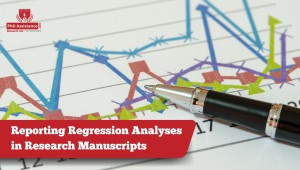Reporting Regression Analysis
Reporting Regression Analyses in Research Manuscripts
Reporting Regression Analyses
- Introduction
- Define the Purpose of the Analysis
- Identify and Summarise Variables
- Confirm Model Assumptions
- Address Data Handling
- Present the Regression Model
- Report Details for Multiple Regression
- Report Regression Coefficients and Statistics
- Evaluate Model Fit and Validation
- Visual Representation
- Name the Statistical Software Used

Recent Post
Introduction
1. Define the Purpose of the Analysis
2. Identify and Summarise Variables
Providing the regression equation is extremely beneficial to provide transparency in the regression analysis so the analysis may be replicated. In the case of simple regression, this would involve stating the equation that identifies the relationship between the dependent variable and the independent variable. For example, the model could be stated as:
Y = β₀ + β₁X₁ + β₂X₂ + … + ε
The regression statement should include all coefficients and predictors when reporting the full equation, especially in more complicated regression models (Whittaker & Schumacker, 2022). Reporting the regression equation allows for transparency and replication by other researchers.
6. Report Details for Multiple Regression
7. Report Regression Coefficients and Statistics
8. Evaluate Model Fit and Validation
9. Visual Representation
10. Name the Statistical Software Used
Conclusion
Need Professional Help with Reporting Regression Analyses for Your Research Work?
PhD Assistance Research Lab has dedicated services to help you report your regression analyses accurately and transparently in your study.
Contact us today to ensure that your study complies with the best statistical reporting practices to enhance the credibility and reproducibility of your research to successfully publish your work!
References
1. Lee, S. W. (2022). Regression analysis for continuous independent variables in medical research: statistical standard and guideline of Life Cycle Committee. Life cycle, 2.
2. Boe, L., Vingan, P. S., Kim, M., Zhang, K. K., Rochlin, D., Matros, E., … & Nelson, J. A. (2024). Methods in regression analysis in surgical oncology research‐best practice guidelines. Journal of Surgical Oncology, 129(1), 183-193.
3. Collins, G. S., Moons, K. G., Dhiman, P., Riley, R. D., Beam, A. L., Van Calster, B., … & Logullo, P. (2024). TRIPOD+ AI statement: updated guidance for reporting clinical prediction models that use regression or machine learning methods. BMJ, 385.
4. Whittaker, T. A., & Schumacker, R. E. (2022). A beginner’s guide to structural equation modeling. Routledge.
5. Zech, A., Hollander, K., Junge, A., Steib, S., Groll, A., Heiner, J., … & Rahlf, A. L. (2022). Sex differences in injury rates in team-sport athletes: a systematic review and meta-regression analysis. Journal of Sport and Health Science, 11(1), 104-114.
6. Andaur Navarro, C. L., Damen, J. A., Takada, T., Nijman, S. W., Dhiman, P., Ma, J., … & Hooft, L. (2022). Completeness of reporting of clinical prediction models developed using supervised machine learning: a systematic review. BMC Medical Research Methodology, 22, 1-13.
7. Nieminen, P. (2022). Application of standardized regression coefficient in meta-analysis. BioMedInformatics, 2(3), 434-458.
8. Goldsmith-Pinkham, P., Hull, P., & Kolesár, M. (2024). Contamination bias in linear regressions. American Economic Review, 114(12), 4015-4051.
9. Barat, M., Jannot, A. S., Dohan, A., & Soyer, P. (2022). How to report and compare quantitative variables in a radiology article. Diagnostic and Interventional Imaging, 103(12), 571-573.
10. Garcia, M., & Thompson, R. (2024). Centralized vs Federated: A Comparative Study of Machine Learning Models in Education. Journal of Artificial Intelligence and Education, 30(3), 200–218.
11. Patel, S., & Garcia, L. (2024). Federated Learning for Collaborative Mental Health Data Sharing. Journal of Education and Data Science, 15(1), 121–140.

